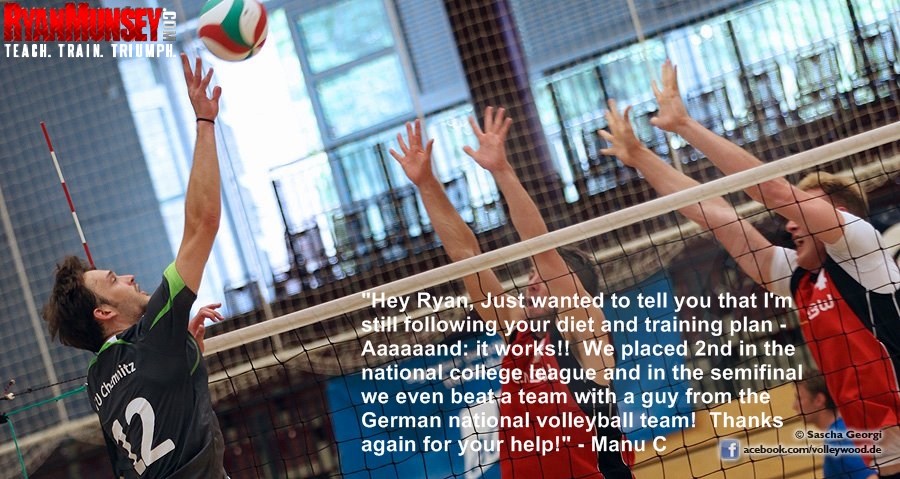I’ve got a BUNCH of athletes who are in-season right now. Those who aren’t, are preparing to be. Even if your competitive days are behind you, there are always time in life that get hectic and require your training volume to go down.
I’m going to show you how to maintain, even gain strength, and improve work capacity while training with less volume and less frequently do to scheduling constraints like games, holidays, travel, whatever.
The Problem
- Most people try to do too much. We’re conditioned (mentally) to believe that more is better. That’s not the case – especially DURING your season. That’s what the off-season was for. If you’re not strong enough or fit enough once the season begins, you’re not going to develop it while taking a pounding from the season itself. Your goal is to MAINTAIN and not lose ground.
[quote style=”1″]Endure when you must. Enjoy when you can.[/quote]
- Right up there with doing too much, is not recovering enough. All to often people spend any free time they have scurrying around trying to stay busy due to this belief that they must keep moving. Know the difference between being busy and being productive. Is the activity your cramming in really going to make you better FOR YOUR NEXT GAME (or whatever event you have)? If YES, then do it. If NO, then don’t. More often than not, rest and recovery are the answer when the body is in situation of constant stress.
- Another mistake from hard-working, hard-training athletes is that they test for and experience their best performance in gym not on-field – WRONG! In-season, the OPPOSITE is true. As an in-season athlete, your #1 priority is to peak and deliver your best performance when it matters most – ON TH FIELD. This also true for business travelers, coaches, and anyone trying to cram training into their busy lives.

The Solution
- Frequency & Volume must be reduced to accommodate the scheduling demands as well as the increasing stress placed on the body. Recovery abilities are reduced during these times, which means training frequency and volume must be reduced to compensate.
- DO NOT reduce the weight/loads used. Frequency and volume have been reduced already. This allows for the lifter to continue lifting heavy – whatever got you there, will also be the thing to keep you there. Don’t intentionally reduce your training loads.
- Prioritize – Know your WHY. Know WHY you’re training. Maybe you’re trying to prevent holiday weight gain. Maybe you’re trying to maintain hip mobility through golf season despite being stuck in a desk and traveling for months on end. Maybe you want to be best 4th quarter defender in your conference. Doesn’t matter, as long as YOU know WHY you’re training. This is the aspect you’ll focus on below.
- Major in the major – not the minor. Remember the 80/20 rule & focus on the 20%. 80% of our results come from 20% of our efforts. The rest is for the off-season. If 80% of your results come from squats, deadlifts, presses, dips, and pullups, then you better not be busting ass on anything else when training in the off-season. Make sense?
- Prehab/rehab, Mobility & Recovery – ALWAYS important. But even more so in-season. 2 reasons: 1) As mentioned above we want our best performances NOW. Makes sense that our bodies should be tuned up and capable – just like a car gets a tune up before that big road trip. 2) During times of high-stress the body is subjected to more dings, bruises, and the like than normal. Add decreased recovery abilities and you see you’re fighting an uphill battle. Do everything you can to tip the scales in your favor – ice baths, soft tissue work, mobility drills, etc.
The Template
I suggest lifting twice per week in-season depending on schedule. For most athletes lifting the day AFTER a game works best as it allows the most recovery time before the next game. Sure performance in the gym might suffer, but remember our goal – to peak on the field!
- Warmup (include mobility and pre-hab)
- Explosive/Activation/Olympic Lift
- High threshold strength work (Main move)
- 2 Accesories in superset
- Finisher
Workout 1
- Warmup (include mobility and pre-hab)
- Box Jumps (8 x 1)
- Squats (work up to 3RM, then 5 x 1)
- Reverse Hypers & RLESS superset (3 x 8 each)
- Circuit of: a) BW lunges b) KB Swings c) Stability Ball Leg Curls (reverse ladder 10 to 1 for time)
Workout 2
- Warmup (include mobility and pre-hab)
- Med Ball Push Press (4 x 4)
- Sandbag Overhead Press (4 x 5)
- Dips & Pullups superset (3 x AMRAP)
- Circuit of: a) Renegade Rows b) Pushups c) band pull aparts (reverse ladder 10 to 1 for time)
